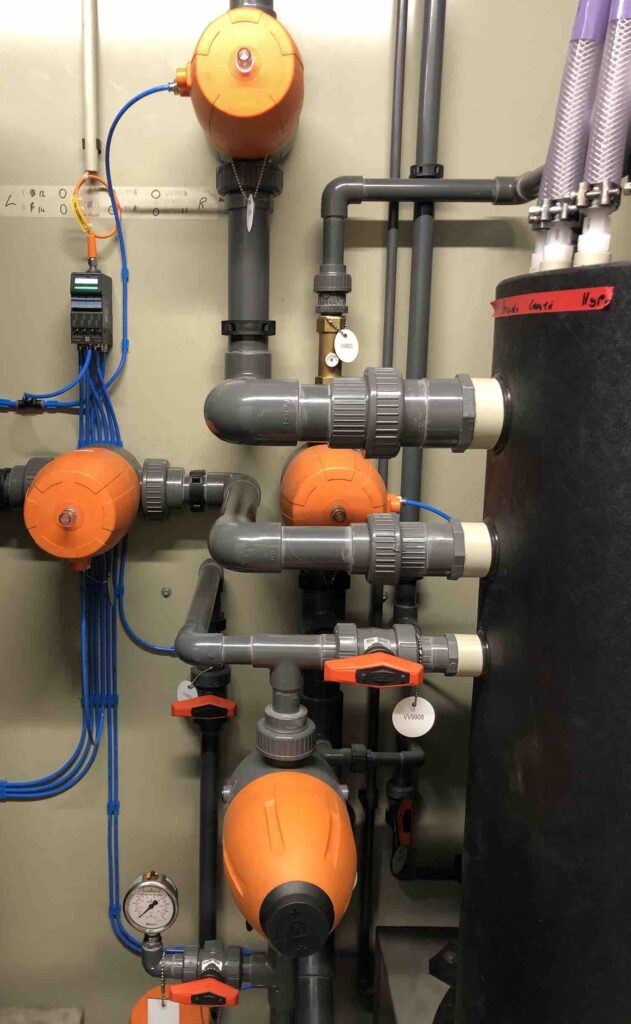Creating improved water treatment processes within the existing plant footprint requires emerging technologies to be tested in real-world applications. The use of pilot plants plays a vital role in fine-tuning this equipment for full-scale operation and Bürkert has supported a variety of key projects including the recent delivery of ceramic membrane ultrafiltration systems to a number of utilities in the UK.
As an expert in ceramic membrane filtration, Nanostone was looking to widen the use of this emerging technology within the UK water treatment sector. Working with Ross-Shire Engineering (RSE), the two companies designed pilot plants that can be used in both clean and wastewater treatment plants. Initially four plants have been constructed to house ceramic ultrafiltration membranes and enable them to be used for the filtration of water. Each plant is leased to the utility for a set period before a decision is made on long-term installation or use on another site.
Solving supply issues
The first two plants were equipped with process control equipment from a supplier nominated by Nanostone. However, the timing of these builds coincided with the increasing worldwide supply challenges. When the time came to manufacture the next two plants, lead times on some parts were being extended significantly. For the process control valve island, the original supplier was not able to provide an expected delivery date within that year.
The Senior Technical Manager at RSE, Paul McCloskey, suggested Bürkert as a parallel supplier that could deliver high-quality products as a direct replacement for the items specified by Nanostone. Aside from the usual specifications for these valve islands, a key attribute was the I/O link and communications protocols that enabled the Bürkert Type 8653 to be used as a direct replacement.
The pilot plants are designed to allow various configurations to be tested to demonstrate the high performance and treated water quality possible from Nanostone’s ceramic ultrafiltration system when treating a wide range of raw water qualities including challenging surface waters and waste waters.

The 8653 used in these pilot plants are IO-Link enabled and do not require Communicator to transfer settings
Compact solutions
Lee Mackenzie, Senior Mechanical Engineer, RSE, commented: “As a designer and manufacturer, changing suppliers in the middle of a project is not ideal, but it did offer us the opportunity to compare the two products side-by-side. The first, and most obvious difference, is the size of the original valve island, the Bürkert product is much more compact.”
Component size is very important in these projects because space is often limited, especially when you are trying to incorporate an additional process in an existing application. Compact controls make installation easier and quicker. In addition, the fact that the Type 8653 can be specified with either IP65 or IP67 protection, makes it very flexible in terms of location.
There is always a concern that design changes will be required to accommodate an alternative component, but in this situation, it was a drop-in replacement, and the time saving was significant. Following a discussion with Bürkert, the precise specification was quickly determined, and the short delivery time brought the pilot project back on schedule.
Pneumatic advantages
Pneumatically controlled valves, as opposed to electromotive designs were selected primarily because the ceramic membranes need to be periodically backwashed and within the pilot plants is an option for an air flush of the membrane feed channels, using compressed air. This pre-existing resource makes the pneumatic control infrastructure more cost-effective than an electromechanical solution.
In addition, the speed of control is also important and pneumatic valves are usually much more reactive than their electromotive counterparts. It was crucial that specific valves within the pilot plants opened and closed within two seconds, any slower and it would cause issues with specific processes.
As soon as each pilot plant was delivered, technicians from RSE completed the installation and commissioning processes, which were simplified by the replacement valve island. Greg Wainhouse, UK Industry Account Manager for Water, explains: “When it came to commissioning, the digital display on the Bürkert valve island made the whole process much easier. The information available on the LCD display means that the technicians do not have to be watching the HMI or the PLC display when the valve settings are being configured. This can save a lot of time when a project is approaching the handover.”
Key communications
To integrate these pilot plants with the wider treatment plant, communication is key. The 8653 used in these pilot plants are IO-Link enabled and do not require Communicator to transfer settings. From the outset, RSE had included components that used IO-Link so the Bürkert valve island was able to fit straight in. Once the first plant was configured, the settings could be transferred to the second plant using the IO Master, making set up and commissioning much easier and quicker.
Three of the four pilot plants have been delivered and installed.
 Engineer News Network The ultimate online news and information resource for today’s engineer
Engineer News Network The ultimate online news and information resource for today’s engineer





